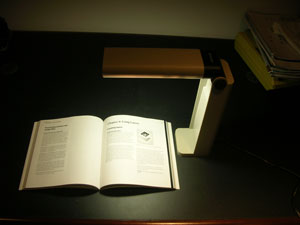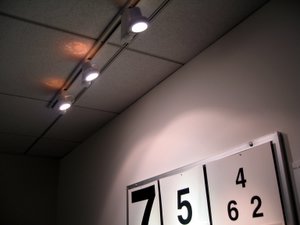Lighting is the most essential element for vision. Without light, we cannot see. Conversely, too much light causes glare and eye discomfort. People with macular degeneration, diabetic retinopathy, glaucoma, retinitis pigmentosa, and other vision conditions require specific levels and colors of light to maximize their vision. For each person, the lighting requirements are specific and one should consult with a low vision optometrist or ophthalmologist and find out the best color temperature of light, the best brightness of light, and the best type of light bulb to maximize vision.
There are many different forms of lighting for indoor use. The incandescent light bulb has been the most popular light bulb for decades but it will soon be discontinued because there are new light bulbs that use less energy, produce less heat, and produce a brighter light of different colors.

Compact Fluorescent Lights
The most frequent replacement for the incandescent light bulb is the compact fluorescent light bulb, sometimes abbreviated as CFL. The CFL bulb consists of a tube slighter larger than the diameter of a pencil that is swirled to produce a bulb approximately the same size as a conventional light bulb. The base of the bulb has threads to allow the bulb to be screwed into most all light fixtures and this will enable people to keep their older lamps.
LED Bulbs
Another common replacement for the incandescent light bulb is the LED bulb, also called the light emitting diode. LED bulbs are very efficient and use less energy that the CFL bulbs. There are many varieties of LED bulbs with various color temperatures. Although the price of an LED bulb is higher than the CFL, the overall cost savings makes them an excellent choice if your eyes respond best to the LED bulb.
How to shop for replacement bulbs
One of the easiest ways to purchase replacement light bulbs for your lamps at home is to go to a light bulb store or to a home improvement store. Take the information provided by your low vision eye doctor and ask a clerk to help you to find the bulb that you need. The following information is the features to search for on the package:
Lumens: Lumens inform you about how much light the bulb will produce. The higher the lumens, the brighter the light.
Temperature: The package of the bulb will describe the Kelvin temperature of the bulb. 2800 degrees will produce a white light with a reddish tint. 3500 degrees will be a whiter light while the 5000 degree bulb will be white with a tint of blue. Ask your doctor about the best temperature color because some bulbs with a temperature over 5000 degrees contain blue light which can be hazardous to the retina of some people’s eyes.
Watts: The watts only tell you how much energy the bulb uses. The lower the wattage, the less energy it consumes.
Base: A medium base is the standard base of the typical incandescent light.
Task Lighting
Task lights are designed to provide the recommended lighting for the specific activity that you are performing. A desk lamp is the most popular task light for reading, writing, paying bills, arts and crafts, and eating. The lamps are small and easy to move from one location to another. The table lamp has a cover that will direct the light from the light bulb directly on the items you want to see. This is very important because light will not shine into the eyes of the user and cause glare. Desk lamps are also positioned close to the table and this increases the amount of light that illuminates the item. The closer the light is to the reading material, the brighter the illumination. Too many times, people with low vision attempt to improve their lighting by installing a brighter bulb in the ceiling. However, the distance between the bulb and the reading materials is too large and one will not be able to see maximally. Some of the most popular desk lamps for people with low vision are the Ott desk lamp and Veralux desk lamps. These lamps are very easy to turn on and off and they provide a wide area of illumination for reading and desk-work.

 Bill Takeshita, OD, FAAO, FCOVD
Bill Takeshita, OD, FAAO, FCOVD
Chief of Optometry, Center for the Partially Sighted
Consulting director of low vision education, Braille Institute

